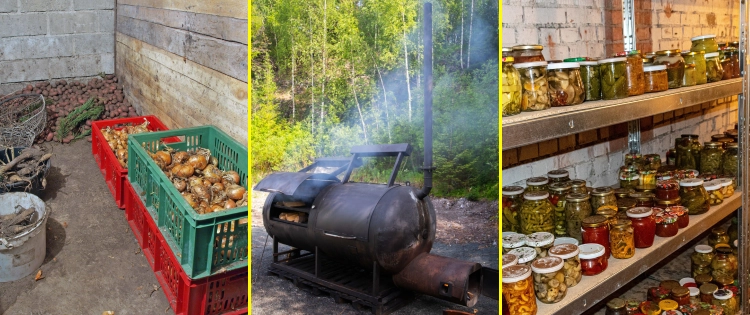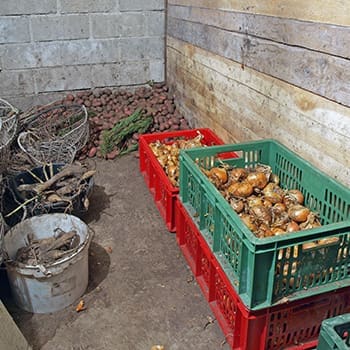Preserving food without electricity may seem like a daunting task in our modern, technology-driven world. But with some tried-and-true methods, you can keep your fruits, vegetables, and meats, and stay fresh for extended periods – no power required!
Whether you’re looking to learn traditional techniques or explore modern alternatives, this article has got you covered. So, roll up your sleeves, and let’s dive in!
Traditional Methods of Food Preservation
Before electricity became a staple in every household, people relied on ingenious methods to keep their food fresh for longer periods. One such method is canning – a process that involves sealing food in jars and heating them to kill bacteria and prevent spoilage. This technique allows you to enjoy your favorite fruits, vegetables, and even meats all year round.
Another traditional method is drying or dehydrating food. By removing moisture from the foods, you inhibit the growth of bacteria and fungi while preserving their flavor. From sun-drying fruits in warmer climates to using specialized dehydrators in cooler regions, this method is versatile and effective.
Fermentation has also stood the test of time as a reliable preservation technique. By using the power of beneficial bacteria, fermentation transforms perishable ingredients into tasty and nutritious foods.
Salt curing is another timeless approach used for preserving meats. The high salt content draws out moisture from the meat, inhibiting bacterial growth and extending its shelf life significantly.
And let’s not forget about smoking! While primarily known for adding delicious flavors to meats like salmon or brisket, smoking also acts as a natural preservative due to its antimicrobial properties.
Planning Ahead for Power Outages
Power outages can happen unexpectedly and you never know how long it will last. That’s why it’s important to plan ahead and be prepared for these situations. Here are some tips on how to preserve your food during a power outage.
It’s essential to have a well-stocked pantry. Keep non-perishable items like canned goods, dried fruits, nuts, and grains on hand. These foods have a long shelf life and can be easily stored without electricity option is investing in a generator. While this may not be feasible for everyone, having a backup power source can make a huge difference during an extended outage. Make sure you have enough fuel stored in case of emergencies.
Consider purchasing coolers or insulated containers that will help keep perishable items cold for longer periods. You can also freeze water bottles or gel packs in advance and place them in the cooler.
Don’t forget about labeling! Properly labeling preserved foods with dates and contents ensures that nothing goes to waste when you’re rummaging through your supplies later.
DIY Projects for Building a Root Cellar or Smokehouse
A root cellar is an underground storage space that provides cool temperatures and high humidity. This makes it ideal for storing fruits, vegetables, and even canned goods. To build one, you’ll need some basic carpentry skills and materials like concrete blocks or lumber. Digging a hole in the ground and creating proper ventilation are also crucial steps.
If smoking meat is more up your alley, consider making a smokehouse. A smokehouse allows you to slow-cook meat while infusing it with delicious smoky flavors. With some simple tools and materials like bricks or metal sheets, you can create your own backyard smokehouse.
By building your own root cellar or smokehouse, you’ll have greater control over the quality of preserved foods while embracing traditional methods of preservation that date back centuries!
Tips for Properly Storing and Labeling Preserved Foods
Properly storing and labeling preserved foods is essential to ensure their freshness and prevent spoilage. Here are some tips to help you out:
- Choose the right containers: opt for glass jars or food-grade plastic containers that have airtight lids. Avoid using metal containers as they can react with acidic foods.
- Clean and dry: before filling your containers, make sure they are clean and dry to prevent any bacteria growth or moisture buildup.
- Use proper packing methods: fill your jars or containers leaving some headspace at the top (around ¼ inch) to allow for expansion during the freezing or canning processes.
- Label everything: clearly label each container with the contents inside, including the date of preservation. This will help you keep track of what you have and when it was made.
- Keep it cool, dark, and dry: store your preserved foods in a cool, dark place like a pantry or root cellar away from direct sunlight and excessive humidity.
- Rotate your stock: to maintain freshness, always use older preserves first before diving into newer ones.
- Regularly check for spoilage: inspect your stored foods regularly for signs of spoilage such as mold growth, off smells, or strange textures.
Preserving food without electricity is not only a practical skill to have, but it also allows you to be self-sufficient even in times of power outages or emergencies.
In today’s world where electricity is so readily available, it’s easy to rely on refrigeration and freezing as primary means of food preservation. However, planning ahead for power outages can help you maintain a sustainable source of preserved foods even when the electrical supply is disrupted.
You may also like:
How To Store Food Without Electricity That Can Last Up To A Year (Video)










